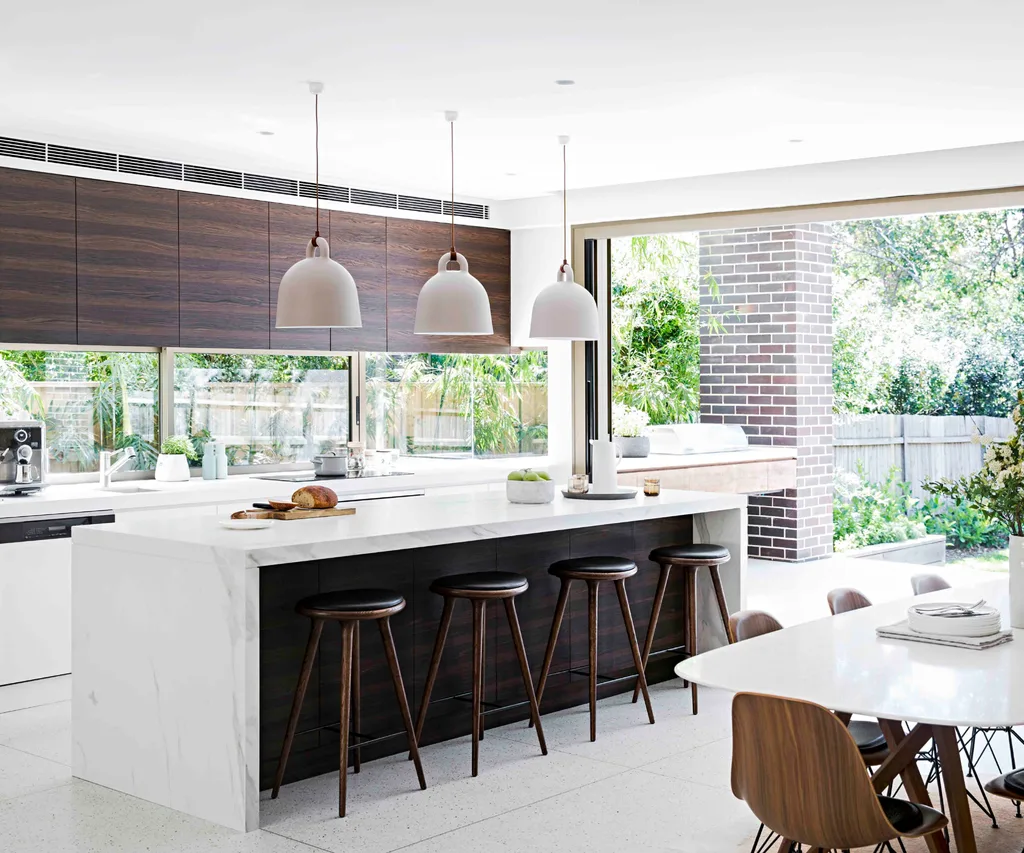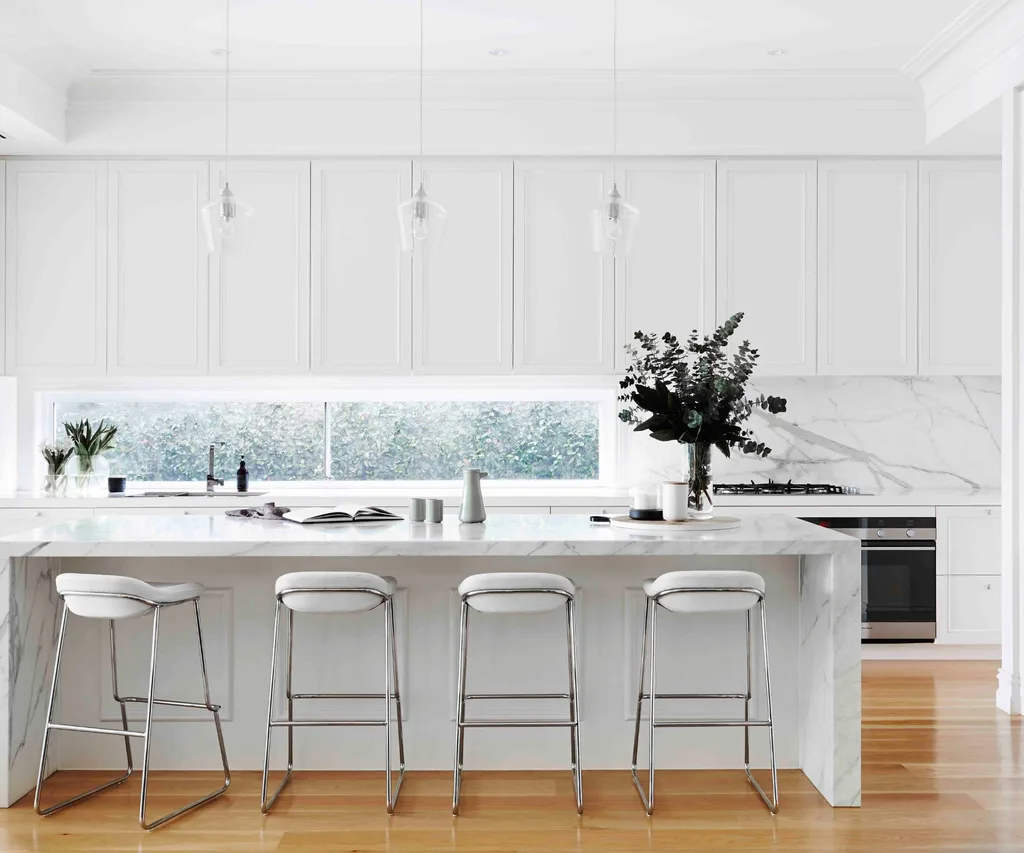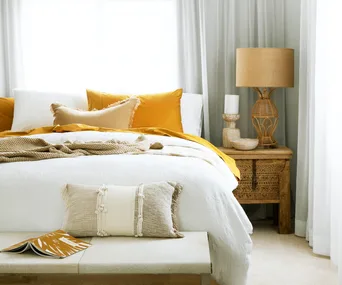Kitchens are one of the most expensive renovation projects to undertake in your home, so it’s essential to ensure you invest in a design that will last. While the all-white kitchen makes for a timeless choice (illustrated spectacularly on these two pages), next year you’ll see it paired with natural elements and bright pops of colour to keep it contemporary. Country and Hamptons-style kitchens are two more examples of classic design styles that are updated every season, while coloured cabinetry, dark timber, marble and brass will be enjoying a moment in 2021.
So, how do you decide which looks are best for your home? We asked a panel of experts for their advice on the current trends and explore the positives (and a few negatives) for each one.
1. bold brass
Brass can be used for tapware, sinks, handles, knobs, lighting and even rangehoods in kitchens, making it a multi-functional material suitable for a variety of tasks. “The greatest pro with brass is that it creates an immediate, beautiful focal point in any room,” explains Daniela Santilli, bathrooms and kitchens merchandising leader at Reece. “But the best way to use brass is to pair it with a neutral colour palette. A black kitchen with brass channels old-world glamour.” “Brass is great at warming up a space and is a striking design choice,” offers Daniela. “But it’s also versatile, robust and, being a warmer-toned metal, it’s very easy to clean with soap and water, plus fingerprints and water marks don’t show easily.”
Brass might come in at a higher costing when compared with chrome finishes, however, it is certainly worth the investment, says Daniela, who views it as a “high-quality” material. “On the whole, brass is often chosen for aesthetic appeal because it adds warmth, looks expensive and is a versatile design choice,” she explains. Brass will darken and change colour with age, which could be viewed as a downfall. However, this natural tarnish will create a beautiful patina over time and is actually seen as a coveted design feature in many kitchen schemes. Lacquered options won’t tarnish over time. “While brass is on the expensive side of things, it has been used in kitchens for centuries, from the 1920s to the 1980s and up to today; this trend just keeps on coming back,” explains Daniela of the metal, used to great effect in this kitchen, at left. “So factor it into your budget as your wow feature and see where you can save elsewhere.”

Brass accents warm up this neutral kitchen scheme. Photographer: Shania Shegedyn
2. dark timber
“Dark timbers are suited to all manner of interior styles,” says Sacha Leagh-Murray, general manager of sales and marketing at Laminex. “From industrial and urban to opulent and refined, they offer an incredible versatility, which is embraced by designers for the warmth and character it brings to any space.”
“Dark timber or veneer cabinetry can be quite a heavy design element in a kitchen, so be sure to balance it with softer colours and materials,” says Kaboodle’s Briony Mikrou. “However, dark cabinetry works wonders as an accent feature, as it can elevate any design and add some serious drama to a kitchen.”
Sometimes porous and absorptive, natural timbers aren’t always suitable for a busy kitchen environment, explains Sacha from Laminex. “In kitchens, where regular cleaning, hygiene, splashing of water and everyday wear and tear are a given, the durability, ease of cleaning, and stain and scratch resistance of laminate is a superior, design-driven and cost-effective option,” she says. But on the plus side: a dark finish, such as the one below, do hide myriad marks.

Photographer: Derek Swalwell
3. magic marble
Known for its luxurious aesthetic, marble can elevate any look in an instant, as seen in this kitchen, at right, by Aaron Wong from Alexander Pollock Interiors. “Marble has been the leading stone used in kitchens for hundreds of years, offering the perfect balance of durability, purity and beauty,” explains Costa Voulgarakis, head of sales and marketing with Euro Marble.
“Nothing says luxury like a marble kitchen island,” says Costa. “It’s an ideal feature for the heart of the home, providing both functionality and opulence. And, while the mere addition of marble benchtops is enough to uplift the aesthetics of your kitchen, pairing it with a matching marble splashback rounds off the design.” Marble is a classic stone that suits any kitchen, be it country, contemporary, Hamptons or otherwise, but it does require extra care. “Due to its porous nature, it is susceptible to scratching, marks and chipping,” explains Costa. “But marble definitely isn’t difficult to maintain at all.” And Costa argues the extra work is worth it. “Marble always has a variety of striations and veining that are unique to each slab – and that’s the beauty of the material,” he says.
Costa says marble (below right) is actually a ‘green’ choice to make. “Marble and natural stone require no chemical processing, which means there are no toxic waste products associated with the construction of a new kitchen, or any emission of harmful gasses,” he explains. While marble, illustrated beautifully on this incredible island, left, is easy to care for, there will be an extra costing above installation. “I always recommend marble be sealed properly upon installation by the stone contractor,” says Costa. “This will prevent liquids and other accidental spills from soaking in and being absorbed, causing stains.”

TIP: “An all-white kitchen can feel sterile if there are no feature colours or texture contrasts to add warmth and visual interest,” says Briony Mikrou, marketing communications manager at Kaboodle Kitchen. “If you’re opting for white, it’s wise to think about what other elements you can introduce to balance the space visually.”


